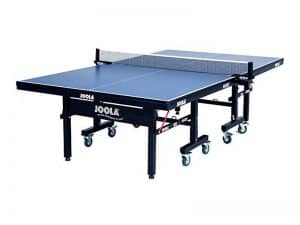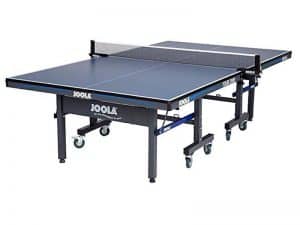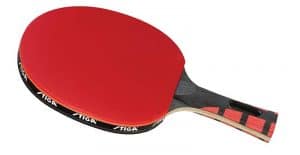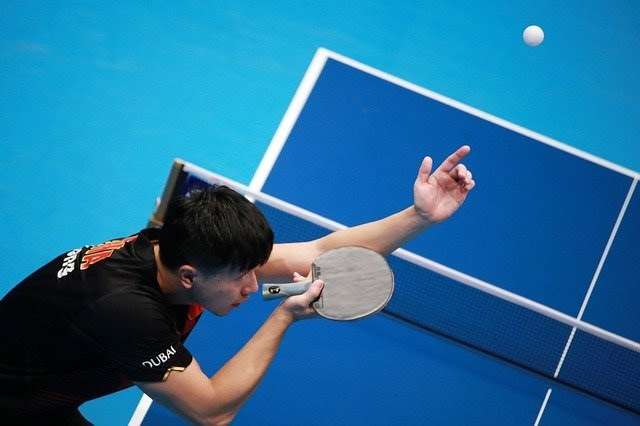5 Best Table Tennis Glues: Reviews and Buying Guide
- Alex Horscroft
- Last updated
Here’s something your probably don’t think about when it comes to equipment: glue!
While more or less every half-decent bat uses table tennis glue, it’s not something we as players put a lot of thought into. But we really should, as it can make tiny alterations to your game. And in a tight match, that could potentially be the difference!
Which table tennis glue is best for your game?
This ultimate guide looks at the different types of glue you can use when putting together your custom racket. We also review each of the best table tennis glues on the market, so you can decide which best fits your preferences.
Table of Contents
The Best Ping Pong Paddle Glue
Table Tennis Glue Buyer’s Guide
To start, let’s dive into all the different types of table tennis glue before helping you choose which is best for you.
Types of Table Tennis Glue
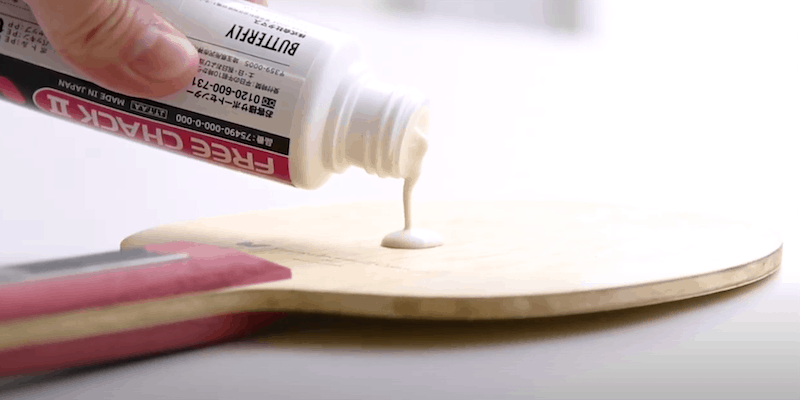
The first thing to mention is that you can’t just use any old glue when putting together your rubber and blade. Believe it or not, certain types of glue are banned by the ITTF (International Federation of Table Tennis).
Below are the most popular options, including those prohibited from tournament play.
VOC Glue (Prohibited)
VOC glues (which stands for volatile organic compound) are banned in table tennis. They contain dangerous and poisonous chemicals, so in 2008 the ITTF banned them. You can tell if a racket uses VOC glue as it has a particular smell, makes a different sound when striking the ball, and tends to weigh more than water-based glues.
Most manufacturers don’t sell table tennis bat glues containing VOC. However, we recommend double-checking that the glue you want is VOC-free, so you stay healthy and within tournament rules.
Speed Glue (Prohibited)
The ITTF also banned speed glue, which contains toxic VOCs that are thought to cause cancer. Players used this glue to get an advantage. The glue vapors cause the rubber to expand, increasing speeds by 10% and spin by 20%.
The effect of this glue is only temporary, though, until all the gas from the solvents has evaporated.
Table tennis speed glue also has a particular smell. This is a big giveaway when detecting whether players have used speed glue in official tournaments. There are other more sophisticated methods of detection it as well.
Boosters and Tuners (Prohibited)
Although boosters/tuners do not act as glue for ping pong paddles, they are involved in the bat make-up process. Like speed glue, the ITTF also prohibits boosters/tuners, partly because some contain VOCs and are harmful to a player’s health.
A few boosters are VOC-free and are therefore not harmful such as the Falco Tempo booster. However, we should note that you should probably still avoid boosting as it is still banned by the ITTF. You could get kicked out of competitions if you get caught using it. So use your own risk!
Boosters cause the sponge to expand, increasing speed and spin by around 10%.
Self-Adhesive Sheets (Authorized)
Another type of glue for table tennis rubbers are self-adhesive sheets. As long as they use VOC-free glue, they are approved by the ITTF.
Pimple players (short pips and long pips) use these sheets, although they are the least popular table tennis glue.
Water-Based Glue (Authorized)
Nowadays, the main glue authorized for all official tournaments is water-based. These glues don’t contain any harmful chemicals and are the only type of glue we recommend.
How to Choose The Right Table Tennis Glue
Choosing the right glue for table tennis rubbers depends on your style of play as well as your preferences when applying. Here are some characteristics to consider:
Strength
Many players prefer ping pong glue that gives them a more substantial impact on their shots. Using stronger glue is helpful with this.
However, stronger glue can risk damaging your rubbers or blade, so it is important to buy high-quality glues that are easy to remove.
Easy To Remove
There’s nothing worse than ruining rubbers or damaging your blade when applying table tennis glue. Our top recommendations are easy to remove when properly applied. Many advanced players change their rubbers every 6 to 7 days, and having the right glue can make this process much more manageable.
You might also want to consider sealing your blade with varnish. This makes it far easier to remove your rubbers.
Drying Speed
Most table tennis glues are fast-drying so that you can use your paddle almost immediately after application. However, some glues can take quite a while to dry.
Even after I glue on my rubbers, I leave my paddle at least overnight to ensure the glue has a strong bond before using my paddle for play.
Thickness
The thicker the glue you choose, the heavier your blade will be, and the more feeling you will lose. This may not seem like a significant factor, but it’s still something you should consider.
Durability
Some professional ping pong players change their rubbers every couple of days. If you’re just playing casually, then you may not change them for months, or even years.
For players who frequently change their rubbers, glue durability is not something you really need to concern yourself with. However, casual players who rarely change their rubbers will want a glue that lasts for months to years with decent playability.
Table Tennis Glue Reviews
Now, let us look at some of the best table tennis glue options on the market today.
#1 REvolution 3 Table Tennis Glue
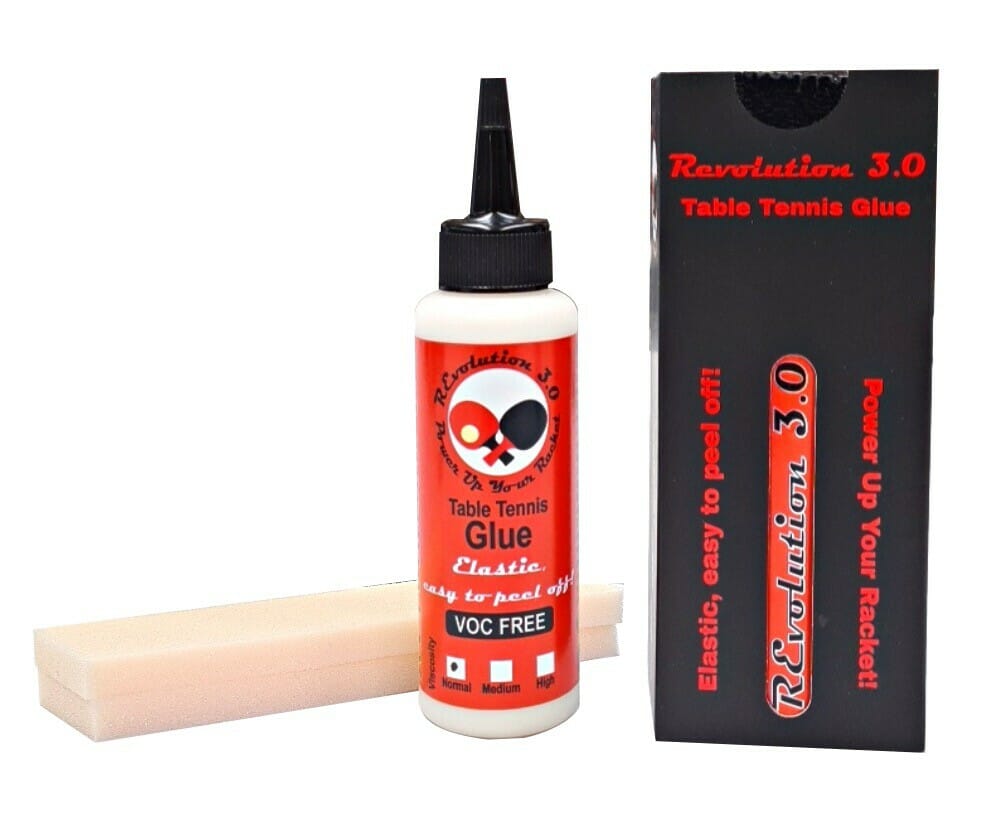
Our first choice for table tennis paddle glue is REvolution 3, one of the most popular water-based VOC-free glues on the market. Over our years of playing, it is the best glue we’ve used, and we love the feel it gives on our rackets. Plus, it’s durable and lasts a long time.
As you’d expect, it’s approved by the ITTF, so you’ll be allowed to use it in official tournaments.
But the best bit about The REvolution 3 glue is it’s easy to peel off the blade when you want to replace your rubbers. It leaves it as good as new without any residue, which will lengthen the life of your blade.
Tip: REvolution recommends you apply three layers of glue on the rubber and two layers on the blade for optimal performance.
If it’s your first time putting together your paddle, then you can buy a kit that has everything you’ll need:
- Rubber press
- Roller
- Cleaner
- Scissors
#2 Butterfly Free Chack Glue
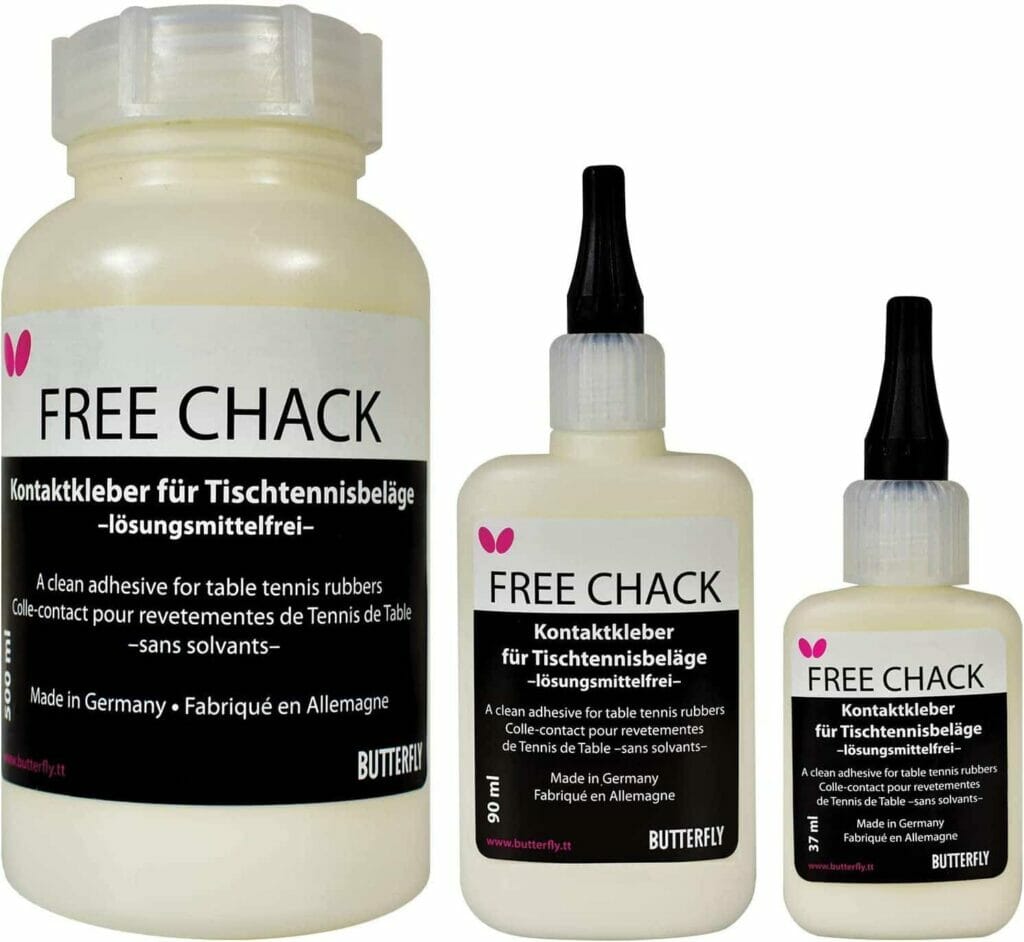
Next, we have the Butterfly Free Chack glue. This is another ITTF-approved glue that is a favorite among professional players because it is so strong. It’s also easy to apply and peels off quickly when you’re ready to replace it. We did notice it can clump if you don’t apply multiple layers though.
The 500ml bottle comes with 50 sponges, and since you will only use 8 to 10ml when sealing two blades, you’ll be set for a while. If you do run out of sponges, you can always buy more. It also comes with a small clamp to help when gluing.
Read Next: How to Make Ping Pong Paddles Sticky
#3 JOOLA X-Glue Green Power
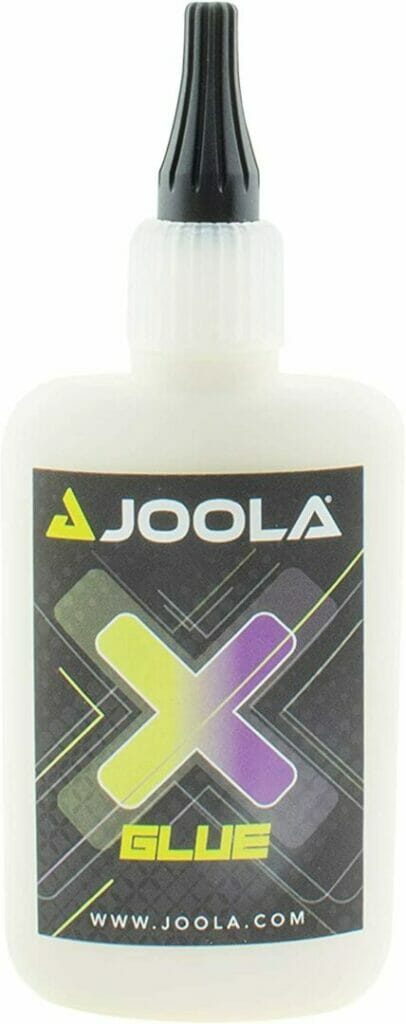
Another option could be the JOOLA X-Glue Green Power. Like the others, it is a water-based glue and is completely solvent-free. It sticks well but can take a bit longer to dry when compared to the REvolution No. 3 glue, which is our #1 choice.
Another downside is the smell is pretty bad. So if you are going to purchase it, make sure you apply the glue in a well-ventilated area. All in all, it’s a good glue for a reasonable price. It doesn’t come with any sponges though, so make sure to get some like this set by JOOLA.
For those that replace their rubbers often and want to buy in bulk, you can get a 1L bottle here, which works out to be very cost-effective.
#4 Butterfly Free Chack 2 Table Tennis Glue
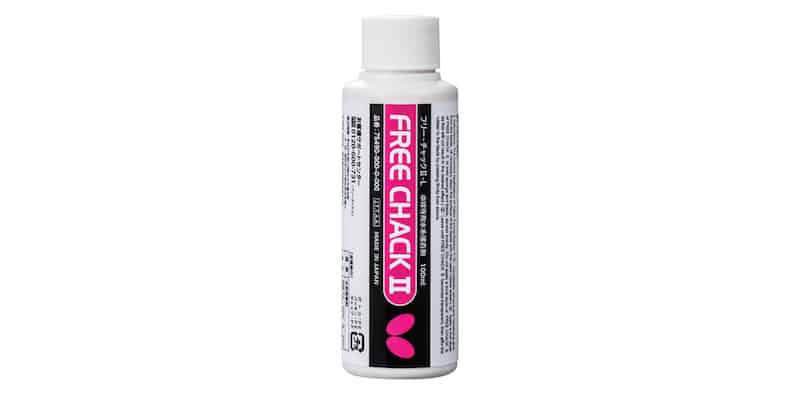
Another water-based table tennis glue from Butterfly is Free Chack II. It is designed for use with Butterfly’s Spring Sponge technology table tennis rubbers such as the Tenergy series.
The difference between the regular Free Chack and this glue is supposed to be the stronger bond. However, we couldn’t quite tell the difference.
It is easy to spread and apply. Plus, removing it when replacing our rubber was a breeze — it peeled right off! We would recommend only using a very thin layer of glue at a time. Then, wait until each layer dries before applying the next layer if you desire multiple layers.
It’s also available as a 500ml bottle if you want to buy in bulk for the best value.
#5 Donic Vario Clean Glue
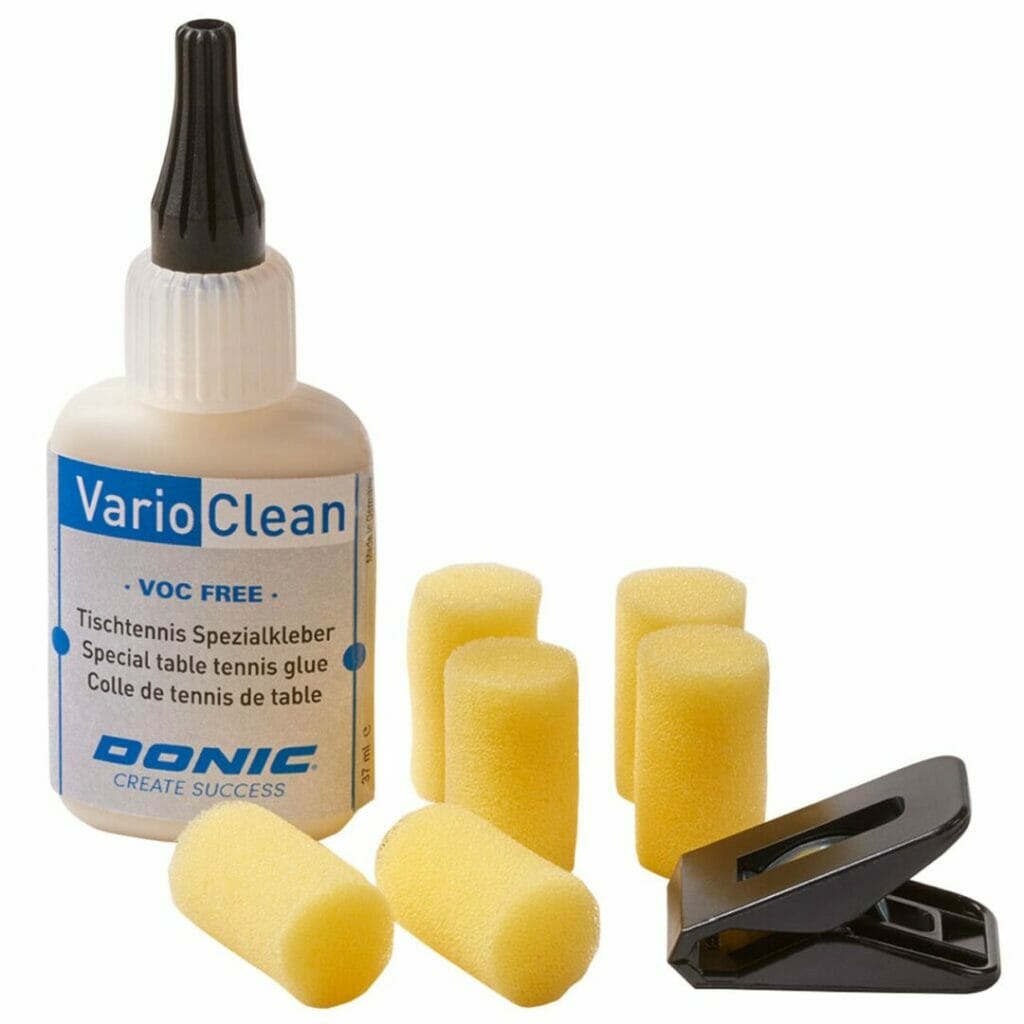
Finally, the last table tennis rubber glue we recommend is the Donic Vario Clean glue. Again, it’s a VOC-free, water-based glue that adheres to the ITTF’s regulations.
This glue is very sticky and thin, so you can get away with using less than for other brands. It’s similar to the Butterfly Free Chack models and comes in at a similar price.
We did find this glue harder to apply and more challenging to remove than our other recommendations. However, if you want lightweight glue and do not change your rubbers often it could work well for you.
How to Glue Table Tennis Rubbers
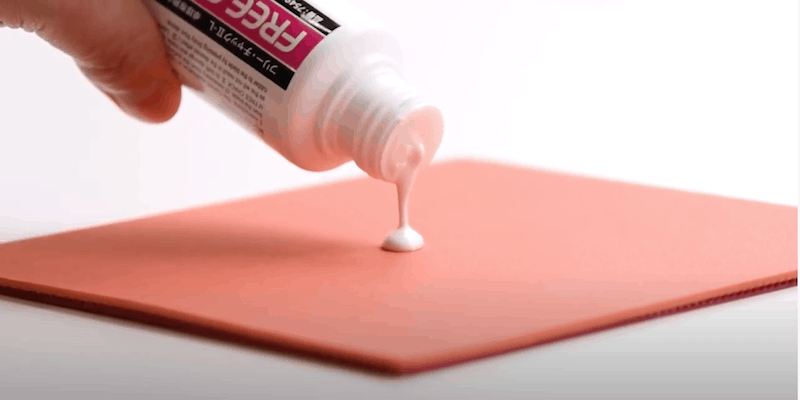
- Ensure you have all equipment ready and your blade is free of old glue residue if you are reusing it.
- Sparingly apply glue to one side of your blade and the sponge side of one rubber sheet. Make sure you cover everywhere in an even coat.
- Wait for your glue to dry before proceeding to the next step.
- With the glue side of your blade facing upwards, grab your rubber sheet with the sponge facing downwards. Then adhere the bottom part of the rubber sheet just above the handle of the blade (make sure to get all the embossing in!).
- Using a rolling pin or tube, slowly adhere the rest of the rubber sheet while rolling outwards.
- Cut off the excess rubber with scissors or an X-Acto knife.
- Repeat the same steps on the other side of the blade.
- As an optional finishing touch, apply edge tape to give your racket a nice clean finish.
Tip 1: Apply Multiple Thin Layers
Depending on which glue you use, it’s best to use multiple thin layers of glue if you desire multiple layers. This helps ensure you coat your rubbers and blade evenly.
Tip 2: Keep Your Glue at Room Temperature
Water-based table tennis glues are temperamental when it comes to temperature and can even freeze if they get too cold. It’s best to assemble your paddle at room temperature to ensure it dries in a reasonable time.
FAQs
How Often Should You Replace Your Rubbers?
This is a tricky question to answer as different rubbers wear out quicker than others, depending on how often you use them. It’s probably time to replace your rubbers if you notice they are not as reactive as before. We recommend changing them at least once a year.
How Many Layers of Glue Do You Need for Table Tennis?
This is dependent on which glue you use and your personal preference. When I use Butterfly Free Chack, I usually only use one coat of glue on the rubbers and one on either side of the blade. However, for Revolution 3, I would use at least twice as much as per their guidelines.
Which Glue Is Best for Table Tennis Rubbers?
We find REvolution 3 to be the best glue for rubbers. It is extremely popular with players and is well priced.
Can You Glue Table Tennis Rubbers?
You have to glue table tennis rubbers to get them to stick to your blade as there are no other legal means of adhesion. Make sure you purchase table tennis glue rather than super glue otherwise, you won’t be able to reuse your blade.
Does Rubber Cement Glue Rubbers?
Rubber cement does glue rubbers, but it is illegal under ITTF rules, and there is no benefit to using it. It contains harmful chemicals, so we recommend you steer clear.
What Other Equipment Do You Need When Changing Table Tennis Rubbers?
Of course, you’ll need your rubbers and blade, but a few other things will help:
- Sponges and clips: To help spread the glue evenly.
- Roller: To attach the rubber to the blade without any air bubbles.
- Rubber Press: Ideal for players who assemble a lot of rackets. It ensures an even distribution of pressure across the whole paddle.
If you’re new to changing table tennis rubbers, then check out our complete guide to replacing your rubbers. Or if you’d rather get them done for you, take advantage of Megaspin’s free racket assembly when you purchase a blade and rubbers from them.
Conclusion
When it comes to table tennis glue, steer clear of anything containing VOC in it! Only go for water-based glues both for your health and to stay within the regulations of the ITTF.
We’d recommend going for either the REvolution 3 or Butterfly Free Chack glues, as they’re the strongest and easiest to apply. We’ve had great results with both of these!
Expect that changing your table tennis rubbers will take some practice too. You might get some air bubbles on your first try, but after a few attempts, you should start to get the hang of it. Good luck!
Read Next: Best Table Tennis Rubbers
Freelance writer. Table tennis enthusiast. Lover of all things online. When I’m not working on my loop game I’m probably binge-watching some fantasy show.
-
Alex Horscrofthttps://pingpongruler.com/author/alex-horscroft/
-
Alex Horscrofthttps://pingpongruler.com/author/alex-horscroft/
-
Alex Horscrofthttps://pingpongruler.com/author/alex-horscroft/
-
Alex Horscrofthttps://pingpongruler.com/author/alex-horscroft/
Popular Products
Join our email list for exclusive reviews & the latest Ping Pong News
Sign up to our newsletter and stay up-to-date with the latest news in the ping pong world, and be the first to read our new product reviews. We promise, no spam












